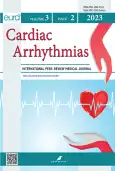Recurrence of Arrhythmias after Thoracoscopic MAZE procedure
- Authors: Lyashenko V.V.1, Ivanchenko A.V.1, Postol A.S.1, Azizov S.N.2, Vygovsky A.B.1, Schneider Y.A.1
-
Affiliations:
- High Medical Technologies Center
- S.G. Sukhanov Federal Centre for Cardiovascular Surgery
- Issue: Vol 3, No 2 (2023)
- Pages: 5-16
- Section: Original Research
- URL: https://journals.rcsi.science/cardar/article/view/160731
- DOI: https://doi.org/10.17816/cardar492331
- ID: 160731
Cite item
Abstract
BACKGROUND: Thoracoscopic version of the MAZE operation alone or in combination with catheter ablation (hybrid approach) has become widespread in the treatment of atrial fibrillation (AFib). However, recurrences of arrhythmias after such operations, in particular recurrence of AFib, remain unresolved problem.
AIM: The aim of this study was to establish the structure of arrhythmia recurrence in patients with long-standing persistent AFib after primary epicardial ablation using the Dallas lesion set technique, as well as determining the optimal RFA strategy for recurrence.
METHODS: 138 catheter ablation procedures for 100 patients, who applied with recurrence of various atrial arrhythmias after thoracoscopic MAZE. 34 patients had 2 or more RFA (31 pts — 2, 2 pts — 3, 1 pts — 4).
RESULTS: After Dallas lesion set thoracoscopic ablation in the structure of recurrences dominated: 1 — AFib recurence; 2 — incisional left atrial flutter. After the operation, a potential arrhythmogenic substrate remains, which must be fully eliminated by RFA (in addition to ablation the main cause of recurrence). This minimally necessary intervention implies: control and reisolation of the pulmonary veins; control and reisolation of the posterior wall; septal line from the mitral valve to the right superior pulmonary vein with Y-shaped branch to the left superior pulmonary vein; cava-tricuspid isthmus-blockade. This will eliminate and prevent in the future potentially possible incisional arrhythmias in fragmentary scars after thoracoscopic MAZE procedure. The return of AFib represents the most difficult group of patients. Restoration of sinus rhythm in recurrent AFib after epicardial ablation is possible, but may require extensive ablations in both atriums, as a result of repeated procedures, until all potential arrhythmia mechanisms, present in a particular patient, are eliminated.
CONCLUSIONS: Catheter ablation remains the only method of effective treatment of recurrences after thoracoscopic MAZE procedure. The complexity and multicomponent nature of long-standing AFib causes the frequent need for repeated procedures, especially in cases of recurrence of atrial fibrillation.
Full Text
##article.viewOnOriginalSite##About the authors
Vitaly V. Lyashenko
High Medical Technologies Center
Author for correspondence.
Email: vitalylyashenko5@gmail.com
ORCID iD: 0000-0002-8501-4801
SPIN-code: 3023-3477
Cardiovascular Surgeon
Russian Federation, KaliningradAndrey V. Ivanchenko
High Medical Technologies Center
Email: ivancha74@gmail.com
ORCID iD: 0000-0001-5501-4926
Head of the Department
Russian Federation, KaliningradAngelika S. Postol
High Medical Technologies Center
Email: postol-75@mail.ru
ORCID iD: 0000-0003-0983-3773
Cardiologist
Russian Federation, KaliningradSardor N. Azizov
S.G. Sukhanov Federal Centre for Cardiovascular Surgery
Email: sazizov@gmail.com
ORCID iD: 0009-0006-1678-9175
Cardiovascular Surgeon
Russian Federation, PermAlexander B. Vygovsky
High Medical Technologies Center
Email: vygovsky@list.ru
ORCID iD: 0000-0003-4832-2028
Deputy Chief Physician
Russian Federation, KaliningradYuri A. Schneider
High Medical Technologies Center
Email: schneider2000@mail.ru
ORCID iD: 0000-0002-5572-3076
MD, Dr. Sci. (Med.), Professor
Russian Federation, KaliningradReferences
- Cox JL, Churyla A, Malaisrie SC, et al. Hybrid Maze Procedure for Long Standing Persistent Atrial Fibrillation. The Annals of Thoracic Surgery. 2018;107(2):610–618. doi: 10.1016/j.athoracsur.2018.06.064
- Pidanov OU, Bogachev-Prokofiev AV, Elesin DA, et al. Thoracoscopic ablation for isolated AFib treatment in Russia. Circulation pathology and Cardio-thoracic surgery. 2018;22(2):14–21. (In Russ.) doi: 10.21688/1681-3472-2018-2-14-21
- On YK, Park KM, Jeong DS, et al. Electrophysiologic results after thoracoscopic ablation for chronic atrial fibrillation. The Annals of Thoracic Surgery. 2015;100(3):1595–1603. doi: 10.1016/j.athoracsur.2015.04.127
- Osmancik P, Budera P, Zdarska E, et al. Electrophysio-logical Findings Following Surgical Thoracoscopic Atrial Fibrillation Ablation. HeartRhythm. 2016;10:981–985. doi: 10.1016/j.hrthm.2016.02.007
- Shilenko PA, Tsoi MD, Cherkes AS, et al. Turnstile left atrial appendage occlusion during thoracoscopic ablation. Cardiology and Cardio-thoracic surgery. 2017;6:57–60. (In Russ.) doi: 10.17116/kardio201710657-60
- Postol AS, Neminushii NM, Ivanchenko AV, et al. Analysis of arrhythmic events in patients group with ICD and hight risk of SCD. Cardiovascular therapy and prophylactic. 2019;18(5):38–46. (In Russ.) doi: 10.15829/1728-8800-2019-5-38-46
- Lyashenko VV, Ivanchenko AV, Postol AS, et al. Electrophysiological mechanisms of arrhythmias after thoracoscopic Maze procedure. Journal of Arrhythmology. 2020;27(2):5–15. (In Russ.) doi: 10.35336/VA-2020-2-5-15
- Lyashenko VV, Ivanchenko AV, Postol AS, et al. Isolation of the posterior wall of the left atrium – different approaches to the same goal. Annaly aritmologii. 2021;18(1):15–25. (In Russ.) doi: 10.15275/annaritmol.2021.1.2
- Gelsomino S, Van Breugel HN, Pison L, et al. Hybrid thoracoscopic and transvenous catheter ablation of atrial fibrillation. Eur J Cardiothoracic Surgery. 2013;45:401–407. doi: 10.1093/ejcts/ezt385
- La Meir M, Gelsomino S, Luca F, et al. Minimally invasive thoracoscopic hybrid treatment of lone atrial fibrillation. Early results of monopolar versus bipolar radiofrequency source. Interact Cardiovasc Thorac Surg. 2012;14:445–450. doi: 10.1093/icvts/ivr142
- Pison L, Gelsomino S, Luca F, et al. Effectiveness and safety of simultaneous hybrid thoracoscopic and endocardial catheter ablation of lone atrial fibrillation. Ann Cardiothorac Surg. 2014;3:38–44. doi: 10.3978/j.issn.2225-319X.2013.12.10
Supplementary files
















